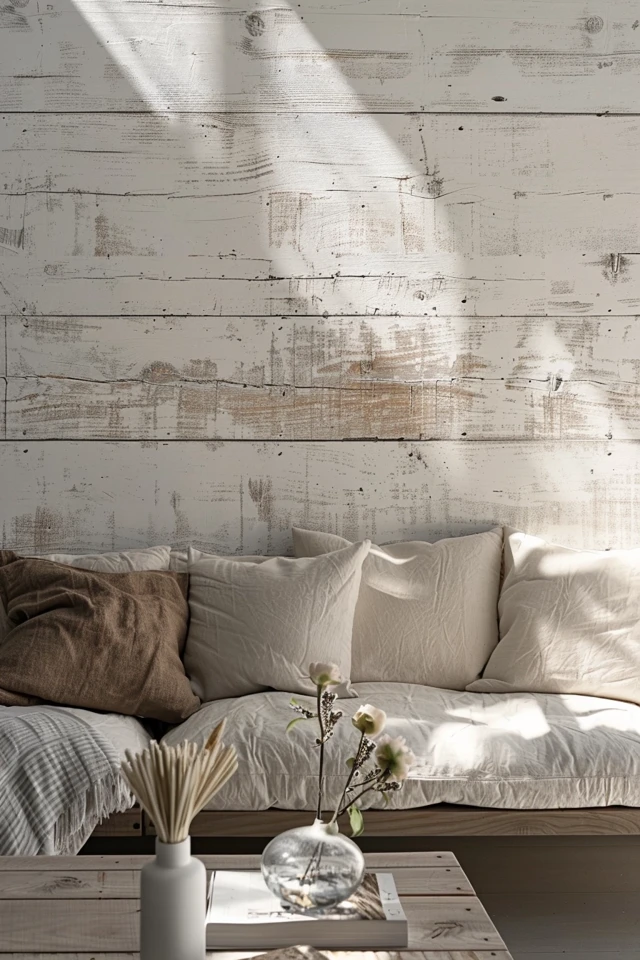Whitewashing walls is a popular technique for achieving a rustic, farmhouse-style finish that can bring charm and character to any space.
By applying a thin, translucent coating of white paint, the natural grain of the wood is highlighted, creating a textured and weathered look. If you’re looking to add a touch of history and a rustic wall finish to your home, this DIY whitewash tutorial will guide you through the process step-by-step.
Before diving into the details, it’s important to note that the information provided here is based on expert advice and tutorials from trusted sources. So you can rest assured that you’ll be equipped with the knowledge and techniques needed to achieve a beautiful whitewashed wall.

Key Takeaways:
- Whitewashing walls is a popular technique for achieving a rustic, farmhouse-style finish.
- The process involves applying a thin, translucent coating of white paint to highlight the natural grain of the wood.
- Whitewash can add charm, texture, and a sense of history to any space.
- Preparing the surface, mixing the whitewash paint, and applying it in the direction of the wood grain are key steps in the process.
- Additional tips include staining the wood a medium brown before whitewashing, using a spray bottle to thin the paint, and dry brushing for unique textures.
Understanding the Whitewashing Process
To achieve a beautiful whitewashed wall, it is essential to follow a few key steps and understand the whitewashing process.
Step 1: Surface Preparation
Before starting the whitewashing process, ensure that the wall surface is clean and free from any existing finishes or debris. This step is crucial for achieving a smooth and even whitewash application.
Step 2: Mixing the Whitewash Paint
Mix your whitewash paint by diluting white water-based paint with water to achieve the desired consistency. The ratio of paint to water will determine the final effect. A 1:3 paint-to-water ratio will give a translucent coating, while a 1:1 ratio will provide a thicker coverage.
Step 3: Application Techniques
When applying the whitewash paint, it is important to work in the direction of the wood grain for a seamless and natural look. Use a brush to apply the paint evenly, ensuring that each stroke follows the grain pattern.

Step 4: Wiping off Excess Paint
After applying the whitewash paint, use a paper towel or rag to gently wipe off the excess paint in the direction of the grain. This technique helps create a beautiful textured finish by allowing the natural wood grain to show through.
Step 5: Repeat and Dry
If desired, repeat the whitewashing steps to achieve the desired level of coverage and opacity. Allow the whitewashed wall to dry completely before moving on to the next step.
Step 6: Seal the Wall
To protect the whitewashed finish and enhance its durability, seal the wall with a clear, water-based polyurethane. This step will ensure that your whitewashed wall maintains its rustic charm for years to come.
By following these steps, you can successfully whitewash your walls and achieve a beautiful rustic finish. Stay tuned for the next section where I will share valuable tips and considerations for whitewashing wood.

Tips and Considerations for Whitewashing Wood
When it comes to whitewashing wood, there are a few essential tips and considerations to keep in mind. These will help you achieve the perfect rustic finish while enhancing the natural beauty of the wood.
First, consider staining the wood a medium brown before applying the whitewash. This technique can enhance the grain and knots, providing more texture and depth to the final result. Applying the whitewash paint in the direction of the wood grain is also crucial, particularly for faux-aged wood. This ensures that the paint evenly coats the surface, giving it an authentic and appealing look.
If the whitewash paint becomes too thick, you can easily thin it down by using a spray bottle filled with water. This helps you achieve the desired consistency and makes the application process smoother. However, it’s important to be careful at the ends of the boards to prevent excessive build-up of paint, which can result in an uneven finish.
Avoid wiping the surface too vigorously after applying the paint, as this may remove some of the whitewash and require additional coats. Instead, opt for a light touch and focus on maintaining consistency throughout the process. If you want to create unique textures, dry brushing can be a great technique. Load your brush lightly with watered-down paint and gently brush it over the surface for an artistic effect.
Lastly, if you make any mistakes while applying the whitewash, don’t worry. Simply use a wet rag to rub off the paint while it is still wet, allowing you to correct any errors and achieve the desired look. Remember, consistency is key, so it’s recommended to whitewash any wood pieces that will be installed in a different direction before installation to ensure a uniform appearance.

